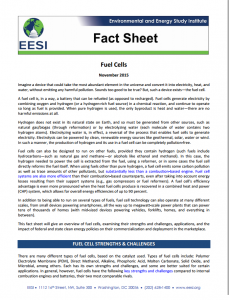Full Title: Fuel Cells
Author(s): Amaury Laporte and Rachael Shook
Publisher(s): Environmental and Energy Study Institute (EESI)
Publication Date: November 1, 2015
Full Text: Download Resource
Description (excerpt):
Imagine a device that could take the most abundant element in the universe and convert it into electricity, heat, and water, without emitting any harmful pollution. Sounds too good to be true? But, such a device exists—the fuel cell.
A fuel cell is, in a way, a battery that can be refueled (as opposed to recharged). Fuel cells generate electricity by combining oxygen and hydrogen (or a hydrogen-rich fuel source) in a chemical reaction, and continue to operate so long as fuel is provided. When pure hydrogen is used, the only byproduct is heat and water—there are no harmful emissions at all.
Hydrogen does not exist in its natural state on Earth, and so must be generated from other sources, such as natural gas/biogas (through reformation) or by electrolyzing water (each molecule of water contains two hydrogen atoms). Electrolyzing water is, in effect, a reversal of the process that enables fuel cells to generate electricity. Electrolysis can be powered by clean, renewable energy sources like geothermal, solar, water or wind. In such a manner, the production of hydrogen and its use in a fuel cell can be completely pollution-free.
